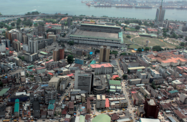To bridge gaps in transport and utilities, Nigeria is set to invest up to $20bn in nationwide infrastructure plans over the next decade, paving the way for broad-based economic expansion.

On March 27 Okechukwu Enelamah, the minister for trade and investment, announced the government plans to accelerate infrastructure investment as a fundamental part of efforts to increase revenue generation.
“Our target is that we’d like to see infrastructure spending increase to the $10bn-to-$20bn range over the next five to 10 years, because we think that’s the level of our need,” Enelamah said during a press briefing.
A committee of public and private sector representatives will be formed to source funding for the programme, with an initial report to be released in the second quarter of this year.
This builds on Nigeria’s efforts in 2018 to boost logistics capacity, such as the Abuja Light Rail System, which opened in July, and the construction and refurbishment of 2539 km of roads.
See also: The Report – Nigeria 2019
The economic costs of the infrastructure deficit
Despite recent works, the shortfall in Nigeria’s transport infrastructure has brought a heavy cost to the economy.
Congestion due to poor port and associated transport infrastructure created losses of N3.5trn ($9.7bn) last year at Nigeria’s maritime logistic hubs, according to a March 2019 report by the research group African Centre for Supply Chain (ACSC). These losses are set to increase as the population expands and economic growth continues.
In the fourth quarter of last year alone, shipping costs for a 40ft container within Lagos went up 400%, while transporting containers from Lagos to the north-western city of Kaduna and south-central city of Onitsha on the eastern bank of the Niger River rose by 66.7% and 120%, respectively.
Exporters are also being impacted, with traffic delays and gridlock at port access routes adding to haulage costs and, in the case of agricultural products and other perishables, causing damage and quality concerns.
The ACSC estimated the average annual loss of agricultural products and perishable items due to poor port infrastructure had risen to $10bn in 2018, imposing significant additional costs on primary producers and exporters.
Bond offerings to generate global and local financing
To meet the need for infrastructure improvements, the new public-private committee will look for alternative funding sources, and it is expected that much of the financial support will come from capital markets.
The same day Enelamah announced the infrastructure investment programme, Zainab Ahmed, the minister of finance, told a Senate hearing that while state revenue flows had improved over the past year, challenges in generating earnings remained, necessitating the tapping of bond markets to support infrastructure development.
“We intend to borrow both locally and internationally, improve on our local borrowing, introduce an infrastructure bond, and to identify new and enhance existing revenue streams,” she said.
The government is looking at an even division between globally and locally raised debt, Ahmed said, with the focus being on concessionary long-term loans. While the minister did not set a value on the proposed bond issuances or other government borrowing, the 2019 budget proposed in December flagged overall debt issuances of N1.7trn ($4.7bn), half of which will be denominated in foreign currencies.
Speaking before the Parliament’s Committee on Works in late March, Babatunde Fashola, the minister of power, works and housing, proposed floating a N10trn ($27.8bn) bond to be used on road, rail, aviation and maritime development, noting that critical infrastructure would encourage economic development and in turn increase government revenue.
Potential concessionary lending to supplement growing appetite for debt
Concessionary loans could also be sourced from international lenders, such as the World Bank and the African Development Bank.
The government plans to weigh all options, with an eye on keeping interest payments in check, Patience Oniha, director-general of the Debt Management Office, told Bloomberg in an interview on March 19.
“If you were to ask me if we’re going to issue eurobonds this year, I’d say we’ll explore all the options,” she said. “Our preferred option is to explore concessional sources. One of our major objectives is to reduce debt-service costs.”
In an encouraging sign, the Central Bank of Nigeria lowered its benchmark lending rate by 50 basis points to 13.5% on March 26, having held it at 14% since mid-2016, indicating an improved outlook for the economy and lower risk levels, which could incentivise foreign and domestic lenders to issue loans at lower interest rates.
Even with the proposed focus on concessionary sourcing of capital, Nigeria’s new infrastructure investment programme will likely offer opportunities to investors willing to capitalise on the country’s appetite for debt as well as long-term benefits that greater efficiency from infrastructure improvements would bring to Africa’s largest economy.


